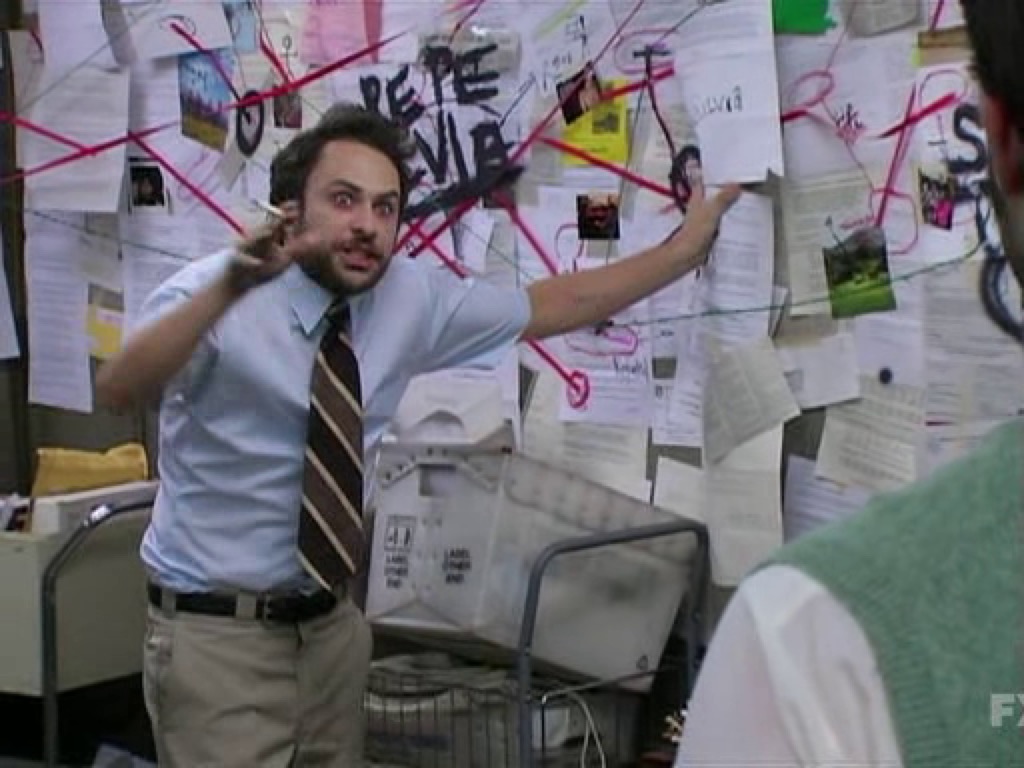You’re probably not going to like hearing this, but when it comes to your current marketing strategy, we’ve got a feeling that you’re probably doing the most.
Like… Drake-confessing-his-love-to-Rihanna-while-announcing-she-won-the-VMA-Vanguard-award doing the most.
If you’re feeling a little called out, don’t worry. We’re not here to judge.
Rather, we’re here to spread some marketing guru wisdom from our friend Casey Slaughter Stanton and help you take your campaign building process from this:

To this:

In a recent interview with Casey Slaughter Stanton, the founder of CMOx, a fractional CMO business, he helped break down the most important factors of creating a cohesive, winning marketing strategy for your brand or biz.
A lot of businesses claim they have a strategy but what they really have are marketing tactics or campaigns they’re going after. In the interview, Casey helped us identify eight things your marketing strategy should include, starting with your vision.
1. Have a clear result in mind.
The first thing every marketing strategy should have is an end result. This is more important than a campaign-by-campaign basis. This is the long term vision or end result of what the leadership in the company wants to achieve. Think 25 years from now.
Start by reflecting on what you/they really want by brainstorming and asking things like, where do you want to live, what do you want to be doing, what impact do you want to make in the world? These results will vary for everyone, but the answers to these questions may bring the leadership in the company to conclusions such as I want to:
- Grow the company, make a whole bunch of money and work as little as possible.
- Work really hard to get VC funding so this business can continue to grow and eventually become the dominant player in the market.
- Grow this business and sell it for profit.
- Grow the business and produce major returns for shareholders.
Four very different outcomes, but all give you a chance to hone in on the goal and make the right choices to get there.
Now, we go from a 25-year vision to a two-year vision. For the two-year business objective, these outcomes need to be tied to revenue, labor (how much you’re working), how big your team is, how will you differentiate, etc.
Next focus on your 90-day objective. What must be true in order for your business to be on track to hit your goals? The key here is to not try to do too much, doing six months of work in 90 days is just silly.
So what you need to focus on here are smaller/tangible steps such as revenue or sales. Once you decide on these, hang these up in a place where the team can see them every day.
Now, you have your vision!
2. Understanding your strengths.
Here’s your daily reminder that wearing a lot of hats is great but, in reality, it often means you might be overlooking the one thing that you can do better than anyone else.
This is where it becomes important that you ask yourself what your greatest strength is.
For example, at Cazayoux Creative, one of our team’s biggest strengths is copywriting, so you don’t see us spending all of our time backlink building. It just wouldn’t make sense.
As you begin to make choices moving toward the goals you laid out in your vision, keep in mind your strategy should be based on what you excel at.
Pro-tip: A great resource for finding personal strengths is The Kolbe index. Taking this yourself and having your team and boss take it can be very beneficial! For example, if you find out your boss isn’t someone who likes all the facts then you will know that giving them a summary will be much more efficient than giving them all the details.
3. Look at what tools and assets you already have.
Your marketing strategy doesn’t have to mean putting out as much content on as many platforms as possible. Instead, it’s an opportunity to think about the things you’ve already done or the campaigns you’re currently working on and using that information in as many ways as possible to reach new audiences.
For example, think about the ebooks, podcasts, webinars and pdfs you’ve worked on. Looking at these resources, think about all of the ways you can repurpose it. The webinar you created might work well as an email campaign, or the ebook you have can be used to create a series of social media posts that reach a different following.
At the end of the day, you don’t have to change your message to get more reach, you can just change the audience you’re sharing with.
For example, we might create a social media template that we want to market to restaurant owners, and instead of creating new content, we can adjust the templates and market to boutique owners.
4. What skills are hiding in your team?
You know what they say. Keep your friends close and your team’s hidden talents closer.
Okay, no one really says that, but if they did, would you listen?
Now is the time to bring back the ice breaker questions from elementary school and get to know your team on a less than surface-level basis. Find out their sleeper skills!
You might find out that your social media manager is secretly sitting on some graphic design skills that could be useful to your next campaign.
5. Who is your ideal customer?
The moment you realize your highest paying customer isn’t your ideal customer is the moment you free yourself to grow your business the way you want.
There’s no arguing that money leads to motivation, but there’s something to be said about finding a customer that continues to give back to your business’s longevity.
Try completing this customer avatar exercise to help you further define who your ideal customer is.
Then get to “know” that customer, fill in the blank of the following prompts and don’t forget to get your team involved too:
- What’s in their head? What are they worried about?
- What’s in their heart? What do they care about?
- What’s in their home? Where do they live? Do they have kids?
Once you understand what’s in their head, heart and home, you can create a clear message for them.
If you’re struggling to gather that information, just ask! After a little research, it can be as simple as reaching out to your clients and saying, “Hey, we really enjoy working with you and want to learn more about your day-to-day!”
Let their response become the words you use in your marketing strategy.
If you don’t feel comfortable reaching out as directly as a phone call, you can always try a survey or check the reviews directly on your products. Use this feedback to pivot your message and capitalize on what works — and what doesn’t.
6. Positioning to solve the problem customers have.
Whether you’re promoting a product or service, you’re selling an experience that is meant to solve whatever problem your ideal customer has.
Once you’ve addressed what that problem is, you need to ask yourself how you can position your goods/service in a way that solves the problem of your customer AND does it in a way that no other competitor can.
To make sense of it all, think about Volvo. Yes, the car model. What comes to mind when you think about Volvo?
Safety. Their branding makes you think of them when you want something safe, reliable and family-friendly. Now, think about Tesla. It’s innovative, new and, let’s be real, kind of sexy.
Both are cars that get you from point A to point B, but they’re positioned differently in the same market to address two separate audiences.
Once you can clarify what differentiates your product or service from others in the same market (i.e. are you going to be family-focused, or all about the sex appeal) you can take that information to your sales team so they can better defend your brand when asked why customers should choose you.
You can also use this in your marketing ads and language as well so it’s consistent.
7. Selling and marketing.
I’ve been waiting for this one.
Up until this moment, everything we’ve talked about has set the foundation for your marketing strategy, but now — now we get to sell because marketing is salesmanship multiplied.
In order to do that, we need to think about what your sales process is. What is your language and follow up like?
If the mention of “follow up” has sent you into a realization that you haven’t followed up with anyone in a while, you’re not alone. But, it is such an important step to go back to when you receive initial leads.
For your marketing process, this is where you consider every possible strategy you can think of and be exhaustive. This list can be 10, 20 or 30 items long and should include your ideas and your team’s ideas.
Once you’ve compiled a master list, it’s time to sift them through the campaign filter. Ask yourself what approach you want to take. Things like:
- What’s the cheapest?
- What brings in the most long-term customers?
- What requires the least amount of CEO involvement?
Once you agree on one or two, your campaign can officially begin.
8. Streamlining and scaling.
Marketing never really takes a break because even after your campaign is live, there’s still work to do.
Now you have to follow up by streamlining (reflecting on what you do better and faster than anyone else) and scaling (getting the most results) your efforts and checking back in with your results.
So, once live, consider reviewing these four junctures every quarter.
Education:
This is where you ask yourself, how much does the consumer know about why your product/service is the best solution to their problem. What if they don’t even know it’s a problem in the first place.
Consider Squatty potty.

The team who marketed Squatty Potty not only had to build a product, but they also had the responsibility of addressing what we like to call a ‘solution unaware’ audience. Aka, they had to teach an entire market that going to the bathroom is good and that this tool could make it better. Now, they’re the leading brand in the market.
As a result, their responsibility in the education process looks a lot different from a competitor who enters the market after the fact and sells a similar product but with LED lights or in another material. The competitor is instead awarded the ease of addressing an audience who no longer has to be taught the benefit, just given a reason to buy elsewhere.
Understanding where your product or service falls on this spectrum is important to create an ongoing campaign that succeeds.
Acquisition:
This step is a little more to the point than education. This is where you start looking at how you get leads and then how to turn those leads into customers once you get them.
Businesses have to have a winning marketing campaign to start before they can really focus on this.
Retention:
Now that you have customers, how do you keep them or, most importantly, how do you get a second transaction out of them? At the end of the day, getting a second transaction from a customer is easier than getting a new one altogether.
Let this be a helpful reminder when it comes to strategizing each quarter.
Remember: You can sell something that has recurring billing just as easily as you can sell something that has a one-time fee, so why sell something with just a one-time fee?
Referrals:
How do you get your consumers to talk to their friends about you and bring in new clientele?
Now that you have four junctures to base your ongoing strategy on, Casey suggests dividing the efforts you extend to each one with each new quarter based on how the last quarter played out.
If your product or service is fairly new like Squatty Potty, that might mean investing 80% of your efforts into education and another 20% into referrals for new clients.
Then, with a focus on the main objectives, you can divide and conquer those efforts within your team by giving your team members smaller two-week tasks to get
Now that you have the tools to create a clear vision, execute a plan with your team and pivot for the future, what will you do with it?
If you’re looking to become a marketing master, check out Casey’s free report on 7 KPIs that all CEOs must know here. If you’re at a point where you know you need more guidance or want to work with a team, send us a message at info@cazayouxcreative.com and let us know how we can help.
